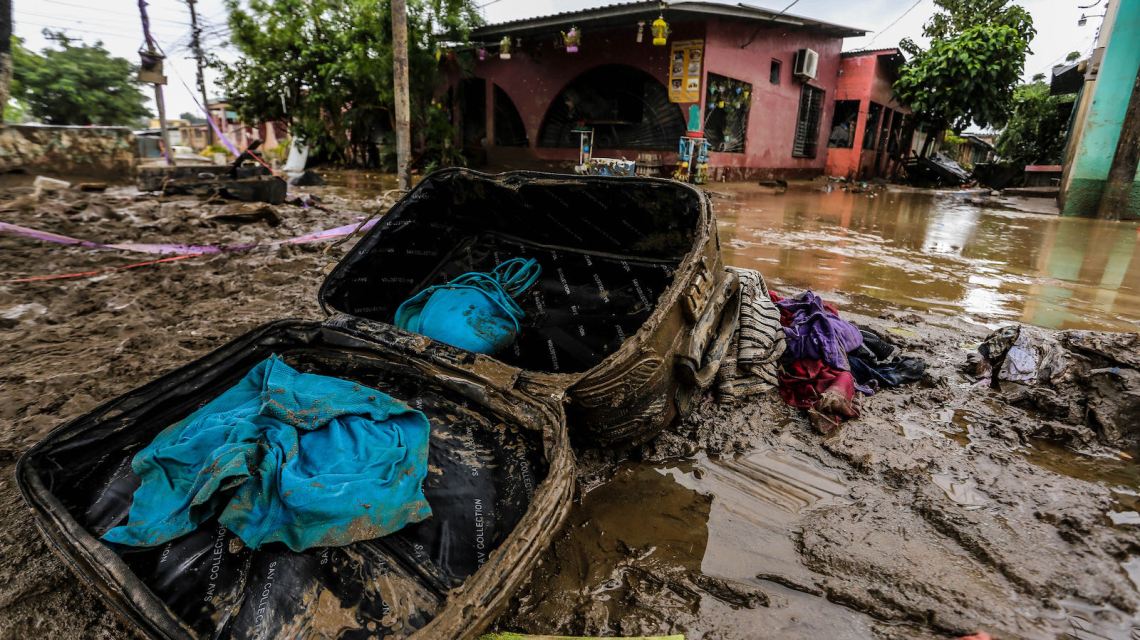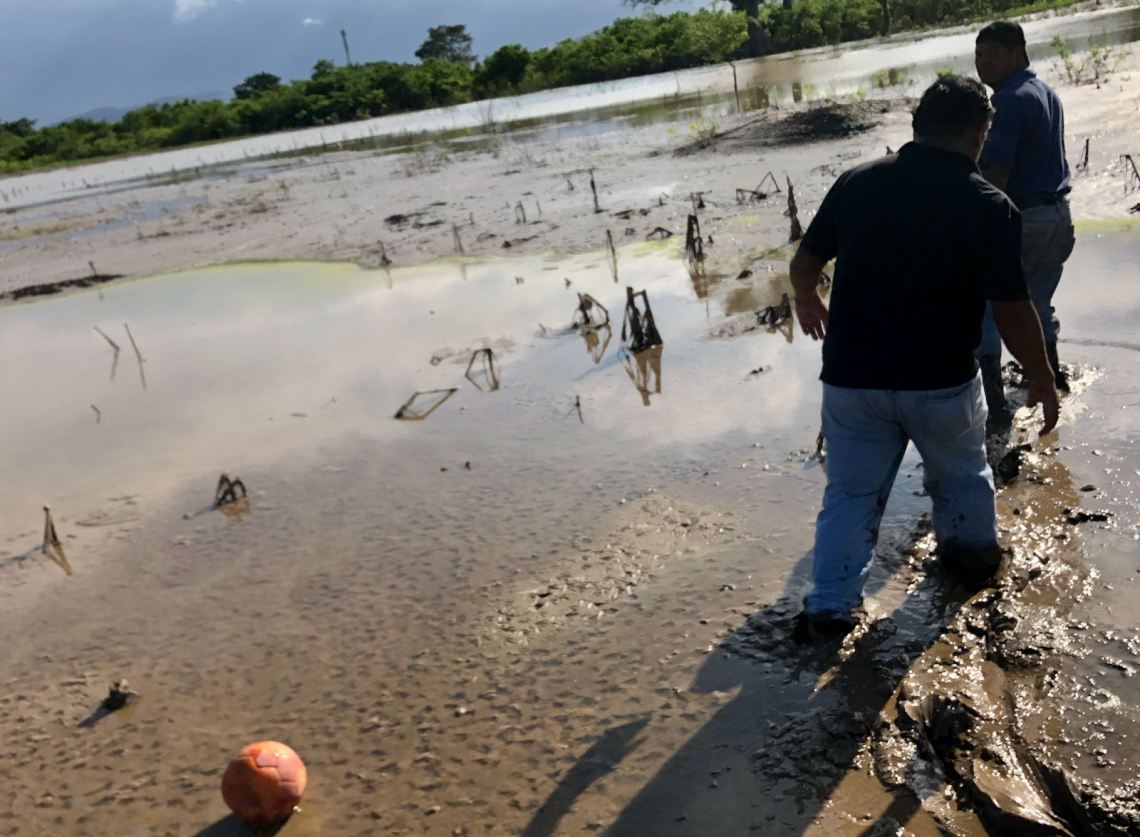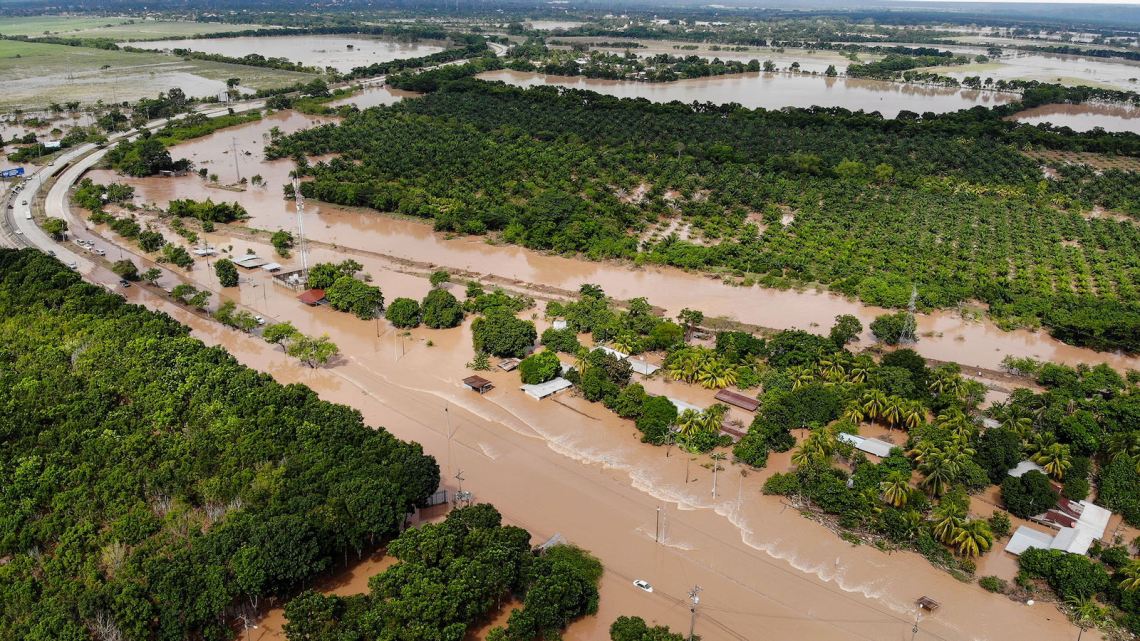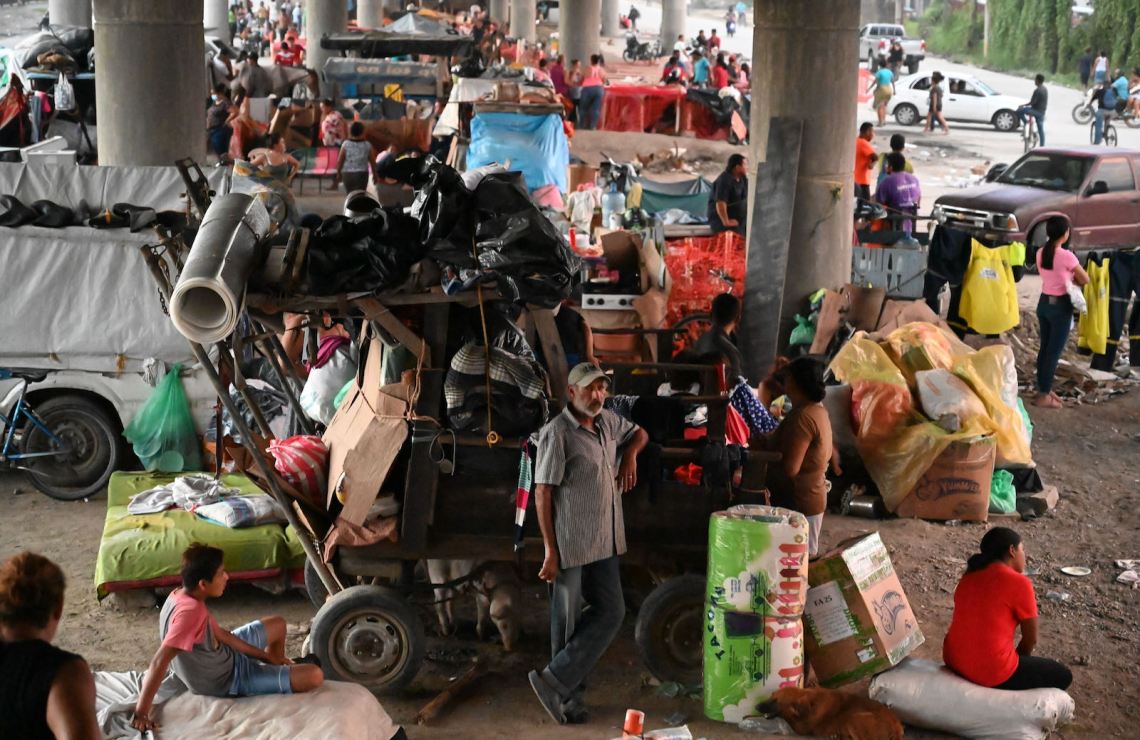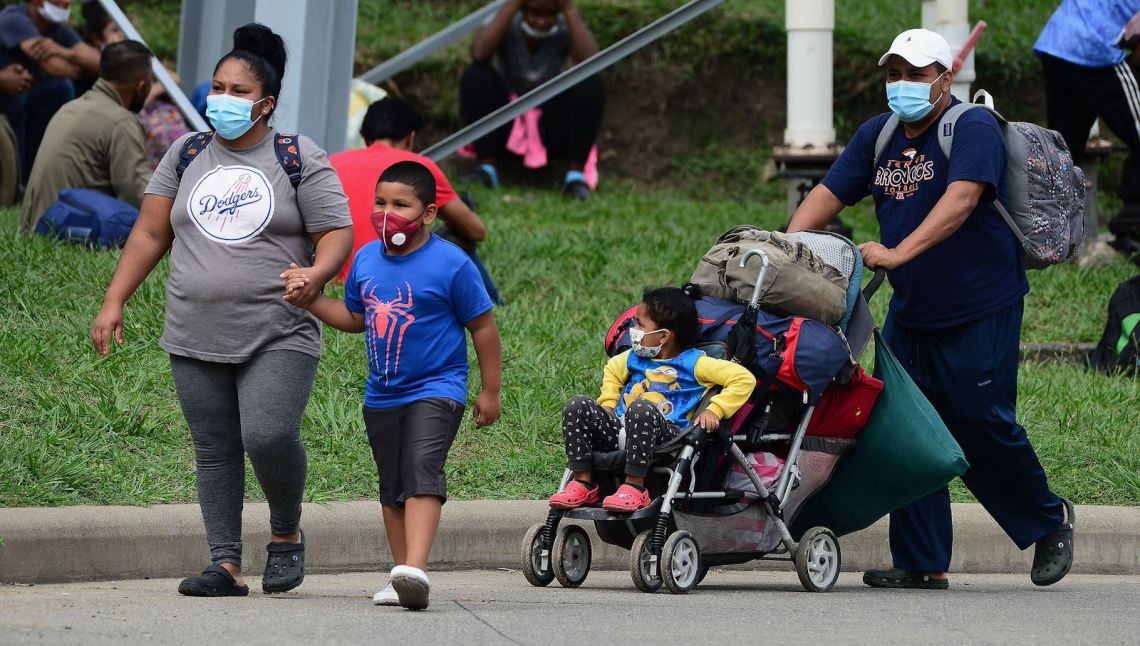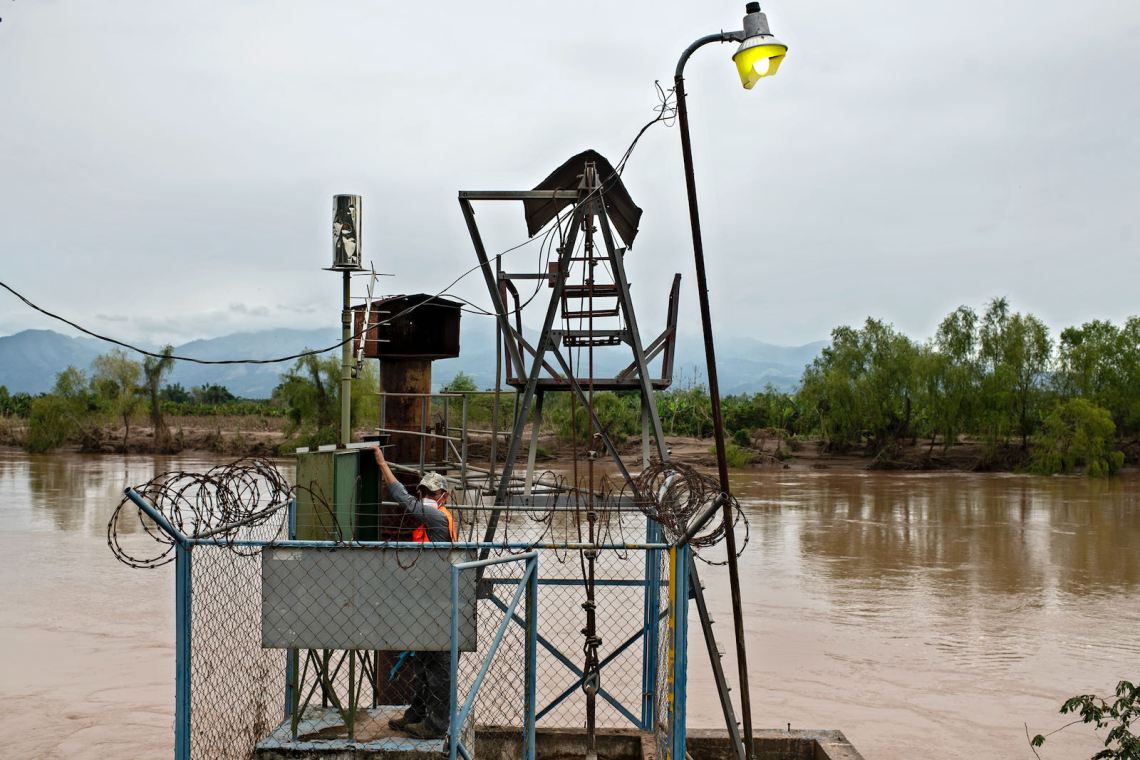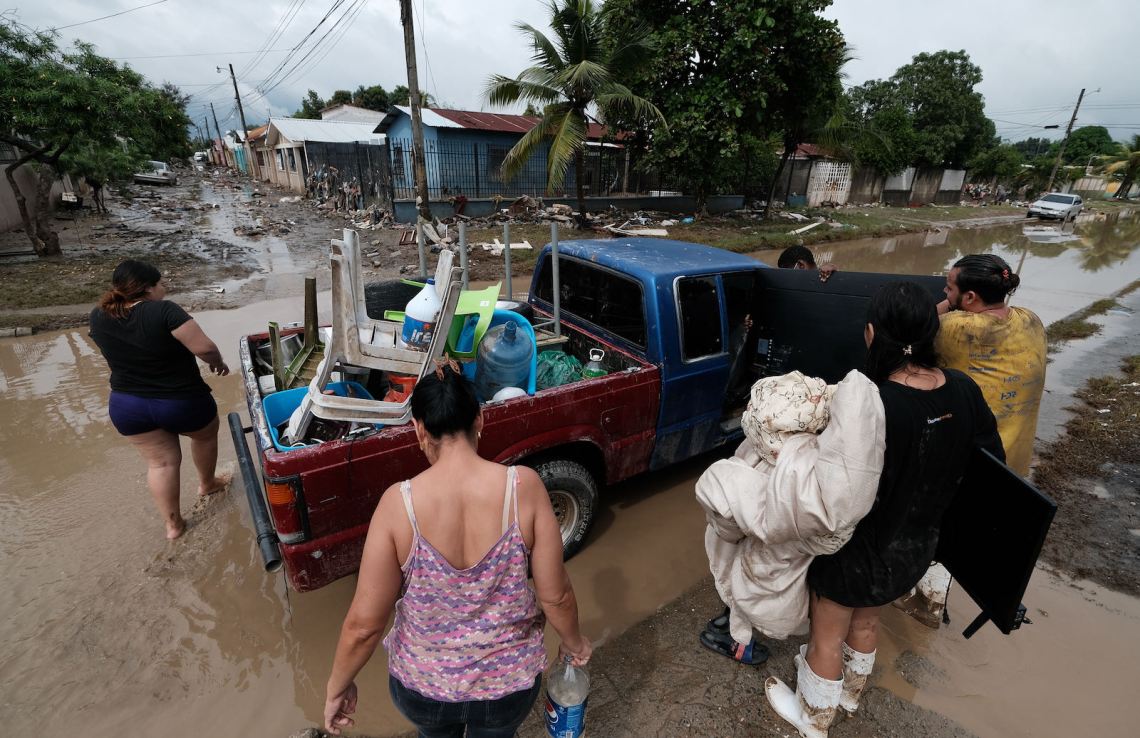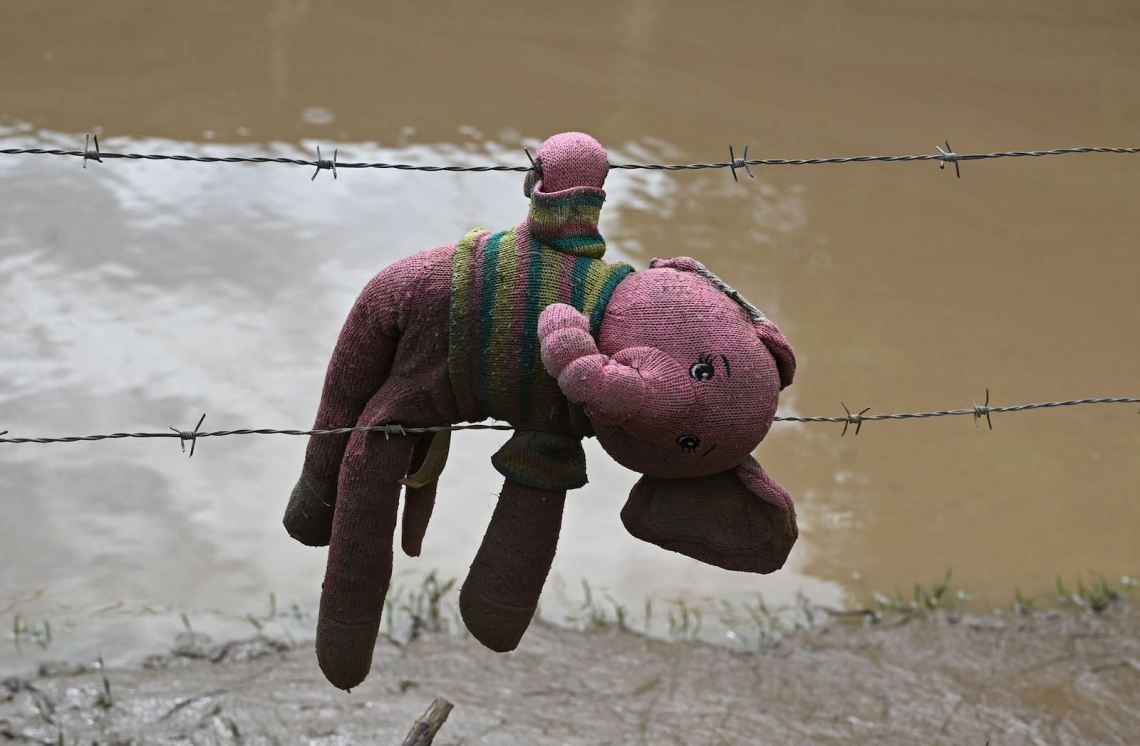They had been told to look for the body in an abandoned lot that straddled an unmarked frontier between gang territories. The area sat on the southeastern edge of the city of San Pedro Sula, the industrial heart of northern Honduras. It was December 9, days after rivers and canals coursing through the city had twice burst their banks during back-to-back hurricanes in early November.
For about an hour, Pastor Daniel Pacheco, an evangelical minister, and Victor Ventura, his guide, had lurched through knee-deep mud, stopping to sniff the air for the telltale stench of decomposing flesh. But their noses were poor guides—everywhere in this barren field a smell of rot drifted over expanses of pooled floodwater, among the household detritus marooned in the brush—a burst mattress twisted against a tree stump, a soiled doll, the wooden skeleton of a chest of drawers.
Even for a country accustomed to violent death, it was hard to know whether the missing cadaver, unclaimed and unidentified, was a victim of drowning in the catastrophic floods that followed the hurricanes or of gang killing. In this sprawling sector of La Rivera Hernandez, the rival gangs Barrio-18 and MS-13, and at least two smaller criminal groups, staked out control block by block. The official national death toll from the hurricanes was just under a hundred, though the government acknowledged that this could be an underestimate (both because the post-disaster chaos made reliable data hard to collect and because widespread mistrust of the authorities meant people often avoided reporting disappearances). In comparison, the police registered 3,496 homicides in 2020; in previous years, at least a third of murders involved criminal groups, including gangs, according to Honduras’ independent National Observatory of Violence.
Ventura was a carpenter whose mud-blasted house and workshop across the road from the field looked like they had been dynamited. It had taken him fifteen years to build up his small business, to purchase his carpentry tools, while striving to keep his two children in school and out of the clutches of the gangs.
Since the waters had receded, he’d spent all his waking hours rummaging through the muck in his house for anything salvageable or scraping out bucketloads of filth from his elderly mother’s place, a few doors down. With no savings, he could not hope to even repair the car he’d bought his son months earlier, an investment to keep the boy fixed on a future at university. Ventura would have to break it down for parts. As for what to do next, “We’ll have to start from zero,” he sighed.
Next was not meant to include searching for the dead. The tip about a body came from a grocer, via a farmer, who’d stumbled upon it when fording the still partly flooded field to check on the sorry state of his corn crop.
No one had called the police. To call the police would invite calamity upon calamity, they all said. The gangs had their spies on every corner. “Hear nothing, see nothing, say nothing” goes the refrain in Honduran barrios. And despite huge recent purges of officers, many on suspicion of drug-trafficking and extrajudicial killing, no one trusted the force. As far as the residents of La Rivera were concerned, the local police were all too likely to “solve” a case by pinning the blame on the first available witness—meaning, often, the person who reported the crime.
Instead, Ventura phoned his friend Pastor Daniel, who, as a man of the church, enjoyed relative protection from both gangs and police. Between his Sunday sermons, Pastor Daniel was a neighborhood peacekeeper who had on occasion persuaded gang members to release a hostage. He surely would know how to honor unidentified dead souls, reasoned Ventura.
Hence this quest. Overhead, vultures circled, plunging in turns to pick at a dead dog. But so far, no human corpse.
*
A mere thirteen days apart, Hurricanes Eta and Iota had slammed into the isthmus of Central America on near-identical paths last year. In a record-shattering Atlantic hurricane season, both Eta and Iota formed as tropical depressions in the Caribbean and strengthened with unprecedented speed before making landfall in Nicaragua and hurtling counterclockwise from Panama to Belize, causing enormous rainfall, deadly torrents, and landslides as they went.“They were some of the most rapidly intensifying hurricanes we’ve ever seen for any time of year,” said Jeff Masters, a meteorologist with the Yale Climate Connection.
Nowhere was the destruction more extensive than in the densely populated industrial and agricultural heartland of northern Honduras. On November 3, Eta’s pummeling precipitation soon overwhelmed waterways’ banks and levees in the region. The tributaries feeding the Sula Valley were already saturated from higher than usual rainfall since May—a stark turnaround after four years of drought, said Juan Jose Reyes, who heads the early warning section of Honduran disaster relief agency COPECO.
Advertisement
Muddy river water rushed through alleyways and across highways, sweeping away thousands of homes, whether wooden shacks or cinderblock houses. Weeks later, vast stretches of the city were still a wasteland. In street after street, the contents of homes lay in mud-slaked piles—the hard-earned assets of people who had already been struggling to subsist in a country with a poverty rate near 50 percent.
At 10:00 AM that day, in barrio Asentamientos Humanos, across the Chamelecon River from the San Pedro Sula airport, another evangelical pastor named Rosa Orbellina stood ankle-deep in her home, frantically trying to bail out the rising water with a kitchen pan. It took a daughter rushing in from her place down the road to rouse her from her panicked trance. They hoisted her bed as best they could and waded out as the waters rose to their knees, then hips, then chests. “If it had been night, we would have all died,” Orbellina told me later.
By 3:00 AM that night, in barrio Cruz de Valencia, Kenya Alcantar and Ismael Nunez had clambered with their two daughters, aged seventeen and fifteen, from their home on the edge of palm and banana plantations to the roof of a shack nearby. When the swirling waters threatened to carry that structure away, they climbed to the branches of a giant tamarind tree. They spent the rest of the night there with some fifty neighbors, yelling at intervals to prevent the community’s children from falling asleep and tumbling from the tree into the wild currents. Three children did plummet down—but with linked arms and adrenaline-fueled ingenuity, even using flotsam for rafts, the whole neighborhood managed to pull and push each other to higher ground. Three weeks later, after the waters had receded enough to allow Kenya and Ismael to return, all that was left standing of the home they’d saved for twelve years to build was the concrete foundation and a bright blue toilet.
The rescue teams had done their best. COPECO led the effort, together with the army, police, firefighters, and the Red Cross. But the currents were too strong for rescue boats in Cruz de Valencia. In Asentamientos Humanos, people said they never saw any. COPECO workers, blamed for their absences and suspected without evidence of stealing international aid shipments, felt it safer sometimes to remove their bright orange vests with the agency’s logo before heading out to help. Some received death threats. Even the more trusted San Pedro Sula firemen had only four boats to haul away people they estimated at tens of thousands. Via USAID, relief workers sent location coordinates of stranded communities to US military Black Hawk helicopters, which airdropped supplies of beans, rice, and cooking oil.
The most vulnerable—and worst hit—districts were settlements along the waterways themselves, populated mainly by trash pickers, tortilla vendors, mechanics, and part-time construction workers. Gangs had long ruled with impunity in these communities. Inevitably, a Barrio-18 crew held up one of the boats that first critical night, forcing firefighters to ferry to safety only their members and their relatives. “Sometimes,” a firefighter told me, “one cannot comment on this type of inquiry because [the gangs] investigate and dispatch you to the other world.”
Two weeks after Eta, as Iota was gathering over the horizon, tens of thousands of people were still sleeping around gasoline stations, several to a mattress in the homes of distant acquaintances, in makeshift tents down the highways, and, in one case, even among the coffins of a funeral parlor. Health officials sent medical teams to government shelters in schools and churches, aiming to isolate anyone with symptoms of Covid-19, but they later admitted that these efforts were largely in vain, as people resisted testing for fear of being removed and losing their chance of having secure shelter. When the second storm struck, the riverbanks, already gouged and breached, never stood a chance; whole districts that had just begun to reappear vanished underwater. Once more, scattered hamlets for miles around were cut off.
Carlos Madero, the minister charged with the government response, told me the two hurricanes constituted the most catastrophic event in the modern history of Honduras. Roving units of Doctors Without Borders reported encountering mass depression: people’s losses, atop the pandemic, atop the chronic violence, amounted to an “emotional bomb,” said the group’s northern Honduras project coordinator, Juan Carlos Arteaga. For some, it was a final sign that was there was nothing left for them in this country.
Advertisement
Even before this natural disaster, Honduras was most often the leading national source of people who told US asylum officers they feared returning home, according to monthly data from April 2018 through December 2019 from the US Citizenship and Immigration Services. It was from San Pedro Sula that the largest of the caravans to make international headlines during the Trump administration departed in October 2018, dubbed by its participants “the Exodus.” Since the floods, plans for new caravans circulated on social media and word of mouth among the fractured communities. The largest reached the border with Guatemala in January with an estimated seven thousand people, but Guatemalan security forces scattered its members with tear gas and batons before they ever neared the barricades of National Guard troops at the Mexican border. Hondurans say they will keep trying, in groups or alone—and their redoubled urge to abandon Central America and head north is already presenting a severe test of President Biden’s resolve to reverse his predecessor’s hardline border policies.
For Ventura and Pastor Daniel, as for so many others who lived in the areas savaged by the storms, the government’s capacity to help had always been limited and fallible. It was even worse now: untold numbers have had to rebuild their lives and livelihoods effectively from scratch. By COPECO’s tally, at least 90,0000 people remained in shelters a month after the storms, and the government was calling for international aid and admitting it was having trouble even assessing the full scale of the problem.
*
For Luis Da’ Costa, though, accountability for the failures exposed by the storm damage was urgent. Da’ Costa is a hydraulic technician at a small government agency called the Commission for the Control of Flooding in the Sula Valley. His job includes checking and maintaining the data from the early warning flood alert system, a system of telemetric stations that measure the flow and height of the water along the two great rivers, the Chamelecon and Ulua, that flow through San Pedro Sula city and the surrounding alluvial plain.
Recent glitches had compounded long-standing infrastructure problems. Of the twenty-nine alert stations meant to monitor water levels on the Sula Valley riverbank, only four were functioning when the first hurricane struck. Covid-19 restrictions limited field trips to check on them; they hadn’t been verified since the spring. And that, said Da’ Costa, had curtailed a perennial struggle against vandalism and robbery. The solar panel charging each alert station could serve for a car or a house. Its transmission device was worth around $16,000. The process of ordering spares from cash-strapped government agencies was byzantine—Da’ Costa had taken to chasing down parts himself.
But they did have accurate weather forecasts: “We knew the threat,” he told me. On October 31, three days before Eta made landfall, Da’ Costa sat watching his favorite YouTube meteorology channel as the hurricane approached. Since then, Da’ Costa has not been able to shake the guilty suspicion that others in the flood commission and senior government officials knew, too. Alerted by the meteorological reports, they had enough information to have warned people to evacuate, he said, and there should have been better coordination between his and other government agencies. He’d advised his boss about the threat, he said. He’d informed an engineer at the Cajon hydroelectric dam. He’d spoken to colleagues at the relief agency COPECO.
This was predictable: Honduran officials had long expounded, with the backing of scientific consensus, on how the country—with its Pacific and Atlantic coasts—was especially vulnerable to extreme weather events that climate change would accelerate or exacerbate. And the country had experienced disastrous hurricanes—notably with Fifi in 1976, and Mitch in 1998. “Everyone expected [another] within twenty years,” Da’ Costa told me.
But how had the Honduran government actually responded? Desperate to kickstart a tourism industry paralyzed by successive pandemic lockdowns, it encouraged people to celebrate the national holiday known as Morazanica Week by heading to the beach. “Right as a tropical storm was developing in the Caribbean,” said Da’ Costa, outraged. No one had wanted to hear bad news before Eta struck, said Marvin Aparicio, head of COPECO’s Incident Command System, noting that the agency had issued warnings as the first storm approached. “People were tired, fed up, saturated with the pandemic measures,” he said.
For Da’ Costa, that was no excuse. “The fact that one person dies, already that’s a failure,” he said. “It shouldn’t have happened.” He, too, had a home he’d been forced to abandon to the floods—in his case in La Planeta, another humble, low-lying district that the local government had long since surrendered to the rule of Barrio-18. His wife was on the verge of divorcing him, he said, for failing to take time off work to help his family rebuild.
Days after the flood, he trudged in rubber boots into the wreckage of his neighborhood, surrounded by the same waterlogged mess of household goods that had become a signature of the deluge: smashed television frames, short-circuited stoves, broken crockery. Incongruously, a child’s inflatable swim ring floated nearby. On one street, a private security guard in uniform stood watch, but the looting of anything electric and still functional began when residents who’d returned to clean up left again for their temporary shelters after sunset.
Having started a family in his early twenties, Da’ Costa never finished his engineering degree but received certification under a USAID-sponsored program after Hurricane Mitch. Furious at his own agency’s failure over Eta, he had begun posting videos of the destruction and spoke up in meetings, risking a reprimand or firing. Over and over, he contemplated resigning. But he couldn’t leave: he still had a mortgage—on his flood-damaged home. A greater weight was his sense of mission. “We must go forward,” he said.
On another day, he drove his pickup down a bumpy road to one of the last four functioning alert stations, in a town called Santiago. The water level “goes down this hose, and the pressure that the water exerts is registered, decoded, and transmitted to a satellite and received worldwide,” he said, fiddling with a small black box next to the swollen Ulua River. But the floods had torn away the hose. For days, the Santiago station had been transmitting random data.
So now the flood commission was down to just three sensors—and meteorologists were predicting more rain. Anyone returning to dig out their homes faced the prospect of rebuilding next to burst riverbanks that no one had yet begun to fix. Because of cost, the levees had never been built to international standards. Instead of more resilient geotextile materials, the banks were mostly just compacted earth—far less resistant to erosion. Over time, informal settlement in areas long since mapped as no-go flood zones had further degraded them. In many places, people had taken to sowing and harvesting crops, including yucca, a root vegetable. Even as they dug for food, they were undermining the region’s already fragile flood defenses.
In Santiago, as elsewhere, when one river had overflowed, its waters swiftly merged with those of a nearby canal. During Eta, “this place, it was all one sea,” said Reynaldo Caballero, a water-level monitor at the Santiago station. As the rains thundered down that first day, he had waded through still-chest-high water to reach the site in time for his shift. One more heavy rainstorm and it could all be one sea again.
*
The worst-hit house on one of the worst-hit blocks of barrio Asentamientos Humanos belonged to Pastor Rosa Orbellina. The barrio’s name means “Human Settlements,” and it, too, was built on a flood zone. Part of the crime-ridden Rivera Hernandez sector, it was home to between 15,000 and 25,000 people, according to two nonprofit organizations. Yet it was ignored by the local municipality, which failed to maintain the roads, provide any amenities that might offer alternatives for the district’s impoverished, gang-lured youth, or even lay a sewage system.
Pastor Orbellina had spent decades of her life here, at times appealing in vain to the local mayor’s office for basic services for the expanding community, as well as watching her children grow up and then helping to raise her grandchildren. She counted some forty members in her congregation. At least she had a receipt of payment for the patch of land that was hers.
After Eta, she was forced to take refuge uptown in a more expensive part of the city, sharing space on a giant mattress in a room that doubled as the kitchen with her daughter, her daughter’s husband, and their two children, and her son, his wife, and their two children.
There, too, her adored eldest grandson, now twenty, was hiding from MS-13, which had repeatedly threatened his life for deserting the gang. When the family’s temporary uptown lease ran out, Pastor Orbellina parted ways with him, weeping. Under threat of reprisal from the gang, he could not set foot in Asentamientos Humanos, nor any other of the patchwork of zones they controlled. That barred him from vast stretches of his own country, but his family could afford nowhere else.
By the time their lease ran out, there had been no progress in repairing her house. She had no money to relay the floors, let alone raise the structure above river level. Her relatives, their livelihoods lost, were too busy hammering back together houses that had more hope of restoration to help.
For now, the weather had held, and the river was flowing within its banks again. “I’m not a knowledgeable person,” she said to me. “But I say that if the banks had been made of rock and cement, the water would not have broken through.” In the last hours before Eta, Orbellina’s relatives had joined neighbors in a desperate race to pack sandbags against the earthen levee, already fearing the worst.
On her first night back, Pastor Orbellina settled into her daughter’s two-room concrete-brick bungalow, her mattress occupying a rare dry spot on the mud-damp cement. Outside, her son-in-law was nailing together slats of tin roofing for a makeshift toilet to replace their destroyed outhouse. She sent her blessings to her congregants. “God was in control of our emotions to overcome all this grief,” she said. “He strengthens us when he tests us.”
Her deepest sorrow, though, she reserved for her now-absent grandson. A day earlier, as the rest of the family packed up to return to their wrecked homes in an MS-13-controlled district, the young man had extracted himself finally from his grandmother’s long, rib-crushing embrace, shouldered his backpack, and walked into his fugitive existence, alone.
Even close family who lived in relatively safer zones had refused her pleas to offer him shelter, terrified of harboring the wanted target of a powerful gang. Their rejection had cut her to the bone. “Because of the increase of wickedness, the heart will grow cold,” she said of them, quoting Matthew 24:12. “Many errors and defects, my grandson, but you cannot imagine how much I love him.”
He had tried to console her with the promise that he would somehow make his way to the United States. For days, they had talked of his joining a caravan. If he made it north, he would work hard and one day have enough to rescue her, too. The idea had become his motivating dream.
But privately, they both had doubts—all too aware that he was just as likely to end up among the lost, unclaimed in an abandoned field, one more in a category of countless disappeared in Honduras yet to be accorded the minimal dignity of becoming a statistic.

